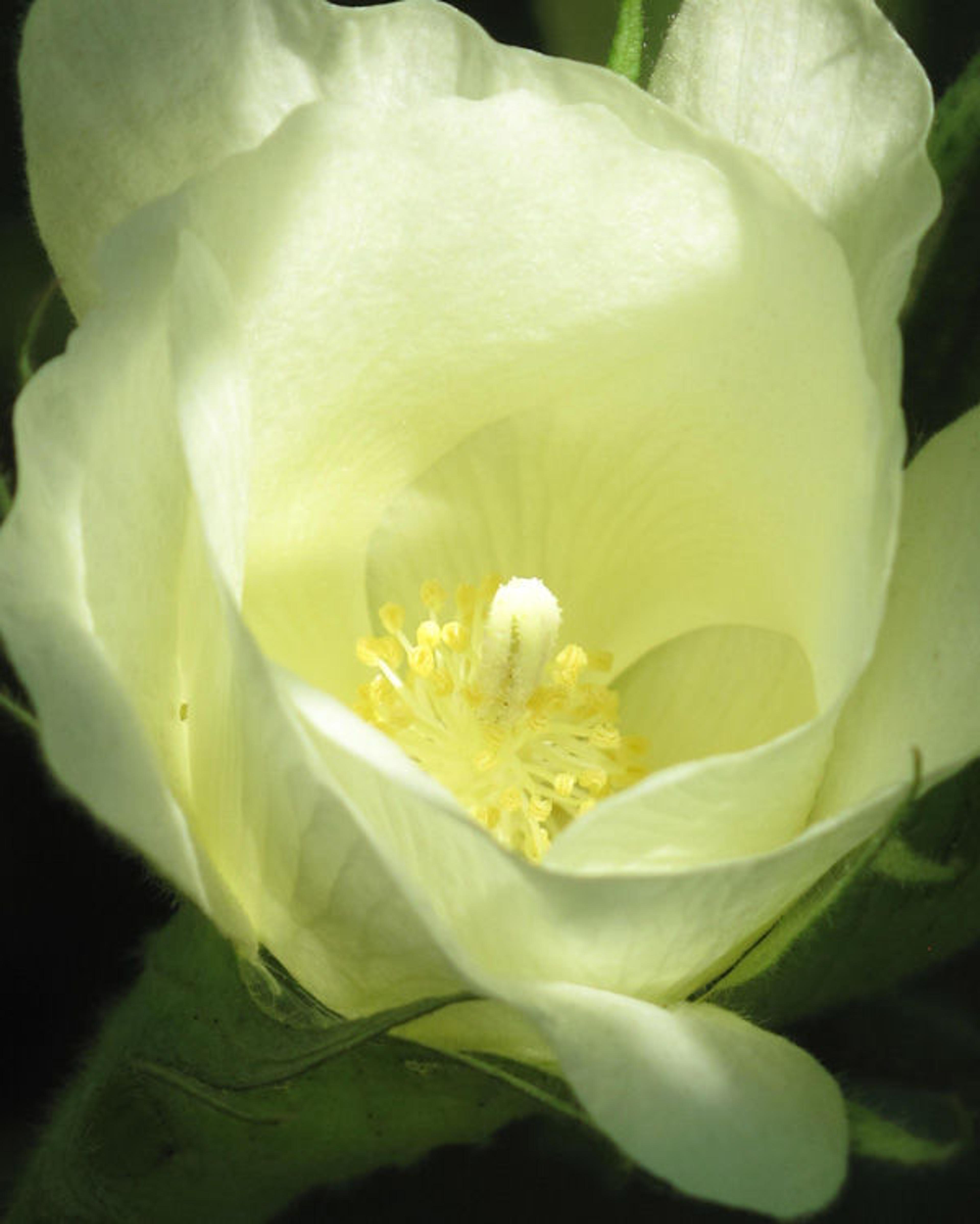
The beautiful Levant cotton grown in Bonnefont Herb Garden. Although Gossypium herbaceum is described as having yellow flowers, our plants are creamy white. Photograph by Carly Still
«Levant cotton (Gossypium herbaceum) is a beautiful plant. I was quickly charmed by its flawless, creamy white flowers, which bloom in our Medieval Artists and Craftsmen bed through the summer months. This economically important fiber plant belongs to the Mallow family (Malvaceae), and is a relative of some of my garden favorites, like the hollyhock (Alcea rosea) and common mallow (Malva sylvestris), both of which are medieval and grown in the medicinal bed.»
Gossypium herbaceum is an Old World species native to Africa and Asia, where its use as a fiber plant has been demonstrated for thousands of years. Cotton is also a New World species, with close to ninety percent of cotton production being supplied from G. hirsutum (from Central America) and another five percent, give or take, supplemented by G. barbadense (from South America).
Levant cotton requires a long, hot summer in order to drop its petals and form fabulous looking "bolls," or seed pods, which ripen and burst open to expose its soft, white cotton fibers. The cotton is then harvested either by hand (the old-fashioned way) or by machine. In Bonnefont Herb Garden, we grow a limited number of each medieval species, but I'm sure the sight of a cotton field would be pretty spectacular.

Levant cotton, shown in Bonnefont Herb Garden this fall, requires high temperatures for its "bolls," or seed pods, to ripen and burst, exposing fine white cotton fibers. Photograph by Carly Still
Cotton found its way into Europe through the Islamic conquests and a fascinating story soon followed, which brings me to the tale of the "vegetable lamb" (Anderson, 139).
Medieval Europeans were tantalized by the mysterious legend of a so-called plant-animal dubbed the "vegetable lamb" or "Barometz," which was believed to be a creature that was part animal and part plant and which supplied soft, white fiber thought to be a type of fine wool. This plant-animal was described as
the fruit of a tree which sprang from a seed like that of a melon, or gourd; and when the fruit or seed-pod of this tree was fully ripe it burst open and disclosed to view within it a little lamb, perfect in form, and in every way resembling an ordinary lamb naturally born… (Lee, 1)
An equally fascinating myth that spread shortly thereafter was that the vegetable lamb was
a living lamb attached by its navel to a short stem rooted in the earth. The stem, or stalk, on which the lamb was thus suspended above the ground was sufficiently flexible to allow the animal to bend downward, and browse on the herbage within its reach. When all the grass within the length of its tether had been consumed the stem withered and the lamb died. This plant-lamb was reported to have bones, blood, and delicate flesh, and to be a favorite food of wolves… (Lee, 2)

Left: An illustration depicting the "vegetable lamb." You can see that small lambs are emerging as the seed pods burst! By Henry Lee [Public domain], via Wikimedia Commons. Right: This fabulous image from botanist Claude Duret's Histoire Admirable des Plantes (1605) portrays the living lamb attached to a stalk by its navel and left to graze on the grass below it. Image courtesy of Wallacegardens.
Both of these fascinating tales were believed in their day; travelers from near and far spoke and wrote about the vegetable lamb. I couldn't resist sharing these little anecdotes about cotton because they are perfect examples of the interesting stories that are carried through the plants grown in our garden. For a short read on the vegetable lamb, see Robert W. Carrubba's "Engelbert Kaempfer and the Myth of the Scythian Lamb" (available on JSTOR).
Sources
Anderson, Frank J., ed. "Herbals through 1500." The Illustrated Bartsch, Vol. 90. New York: Abaris, 1984.
Carrubba, Robert W. "Engelbert Kaempfer and the Myth of the Scythian Lamb." The Classical World, Vol. 87, No. 1 (Sep.–Oct., 1993): 41–47. doi:10.2307/4351440.
Lee, Henry. The Vegetable Lamb of Tartary; A Curious Fable of The Cotton Plant, London: Sampson Low, Marston, Searle, & Rivington, 1887. Reprinted by Forgotten Books in 2012.